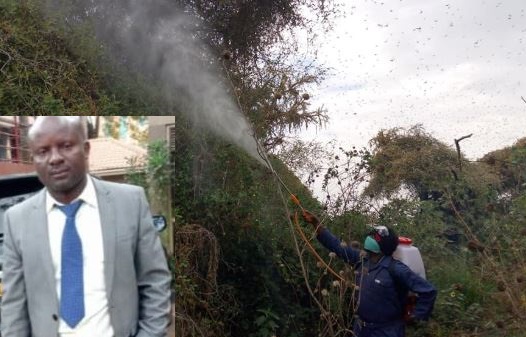By Ellady Muyambi
Dear Spy Uganda Editor,
As you might be aware, three swarms of desert locusts entered Uganda’s Karamoja sub-region on Wednesday 12th February, 2020, through Kenya’s Kesai region. The locusts entered through the districts of Amudat, Nabilatuk and Nakapiripit.
As of today, more than eight other swarms of the notorious desert locusts have since entered the country and are now spread into: – Karamoja, Teso, Acholi, Lango and Sebei sub-regions. So far more than 25 districts have already been affected by these desert locusts with major occurrences in the districts of: – Abim, Agago, Amudat, Kabong, Katakwi, Kitgum, Kole, Nakapiripirit, Moroto and Soroti among others.
As a result, over 10,000 litres of the pesticide Fenitrothion were procured by the government of the Republic Uganda from Japan, at a total cost of Shs2.8Bn. The chemical was shipped from Japan to Nairobi, Kenya in solid form, from where it was re-processed and mixed into liquid form. From Nairobi, the liquid form pesticide was airlifted to the Soroti Central Stores in Uganda free of charge by the Food and Agricultural Organization (FAO). Reliable information also reveals the use of Chlorpyrifos which has been banned in most of the developed world countries.

More than 2000 soldiers from Olilim Army Barracks and members of the Local Defense Units (LDUs) from the above sub-regions were assembled without any prior training to begin the spraying of the desert locusts.
Spraying started in Nakasepan village in Amudat sub-county in Amudat district, Komerot village in Mourita sub-county in Nakapiripit district on Thursday 13th February, 2020. Interestingly, these soldiers conduct some of their operations at night.
Massive aerial spraying using one aircraft hired from Kibimba Rice Scheme in Tororo district and another one from the government of the Republic of Kenya, as well as others from the UPDF is expected to commence soon as well. Besides the over Shs20Bn previously spent on the spraying exercise, an additional Shs16Bn has also been approved by Cabinet.
Although the Ministry of agriculture officials claim that they are handling the exercise with the technical support from the East African Desert Locust Control Organization (DLCO-EA) and the food and agriculture Organization (FAO), I highly believe that the whole exercise is being implemented without following the set standards and without due consideration of the impacts the chemicals shall have on human health and the environment.
Scientifically, chemically spraying the desert locusts in Uganda will have both; occupational and non-occupational, as well as short and long term effects. Some of the soldiers and other local people have been seen spraying the chemicals without protective gears such as masks, helmets, gloves etc, which exposes their lives to danger. The chemicals being used will kill most of the pollinators such as bees and other flies; affect the soil and community water sources.
Besides, people in some of the sprayed areas like in Kitgum district have been seen collecting basins and sacks of the dead desert locusts killed by the pesticides and upon collection, they wash them, cook them fully, dry them in the sun for 1-2days, fry them with cooking oil and then eat them. Reports from these incidents show that some of the residents who have eaten these chemical contaminated desert locusts have developed health complications including swelling of the stomachs.
In dealing with emergencies, governments, especially in Africa, often resort to military tactics where the end justifies the means.
Emergency goals are often the short term results that can be achieved as rapidly as possible but the resultant effects often appear positive and dramatic – threat neutralized.
The operational costs are often easy to quantify and bundied across media houses- often touted as success by governments. The human and ecological costs are never factored in.
I therefore greatly lament the possible human costs of the exercise of chemical spraying of the desert locusts – actually “human wastage”.
I thus submit that there is need to monitor all aspects of the ongoing chemical spraying exercise of the desert locusts in Uganda. But more than that, there is also need for occupational health training on the one hand and training of the general population on chemical safety aspects on their new found culinary thrill.
There is need to mount epidemiological surveillance on chemical poisoning and possible interventions. This is an exercise that requires a multi-disciplinary approach including clinicians and toxicologists with good laboratory support to determine the human chemical loads and possibly burdens in the vulnerable populations.
Additionally, it would be a good idea to begin conversation over the treatment and disposal of the chemically contaminated dead locusts. Burning them up must be avoided due to vapourization of the chemicals as well as reaction of toxins and furans.
Also, there is the issue of eco toxicity and the fate of the active molecules in the pesticide used which need to be determined and kept in check. The sprayed fields will be cultivated again and planted. Therefore, the issue of bio-accumulation through plant uptake is the cornerstone of our concern and should be one of the parameters for monitoring.
The writer is the Secretary General, Uganda Network on Toxic Free Malaria Control (UNETMAC), a non-governmental organization in Uganda whose aim is to promote a malaria free world as well as a toxic free future. Tel: +256 (0) 775 496 206, Email: elladmuyambi@yahoo.com





